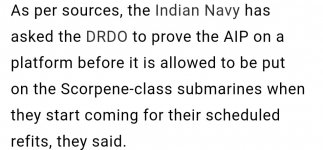Spain's Navantia has had one setback after another in the design of its new class of S-80 attack submarines.
Another setback that must make DCNS (Naval Group) engineers smile: the French industrial group had blasted the attitude of the Spanish group Navantia, ten years ago. Since the 1990s, the two groups had been in partnership for the design of Scorpene-type submarines... until Navantia made "a child in the back" to the French group. In 2008, the Spaniards abruptly withdrew from the Scorpene project (keeping the accumulated knowledge), to build, in collaboration with the Americans, the S-80 class. The latter will be in direct competition, on the international markets, with the Scorpene... now 100% French, after a negotiation before the International Court of Arbitration, to consummate the divorce.
The old proverb For want of a nail about a king who lost his kingdom because his horse had a faulty shoe nail is a staple in school to teach us that the little things can make a world of difference. Like a mistake caused by a misplaced decimal point that can take years and cost billions to rectify!
The S-80 project has seemingly become a laughing stock for technology mismanagement and planning.
The first of four S-80 class submarines was expected to be ready by 2015, but its builders and the Spanish Navy uncovered a potentially fatal flaw in its design in 2013. The first S-80 was over 100 tonnes heavier than specified and serious doubts emerged about its capability to resurface from underwater. Personnel in Spain's ministry of defence later attributed the problem to the fact that the design team had “misplaced” a decimal point in weight calculations and the navy had added new systems to the submarines.
To modify the defects on the S-80 design, the Spanish government contracted the services of an American submarine builder, Electric Boat. Electric Boat and Navantia then “resolved” the weight problem of the S-80, by lengthening the submarine's hull by over 8 metres to nearly 80 metres, also adding hundreds of tonnes in displacement.
The S-80 submarines, which will now displace over 3,000 tonnes underwater, have a new problem, though—they are now too long to be docked at the Spanish Navy's base at Cartagena.
The cost of the S-80 project is expected to reach nearly euro 4 billion, from the initial budget—allocated in the previous decade—of euro 2 billion.
As a result of the weight and length problems, the first S-80 submarine is expected to enter service only by 2022, nearly seven years late. The submarine is also having problems with its fuel cell air-independent propulsion (AIP) system.
The irony of the story does not end there: the modifications could not be applied to the first of the four models. The S-81 (Isaac Peral) was already too far advanced in its construction and would only be modified after delivery. The AIP propulsion system, which allows the submarine to stay underwater for a fortnight, may not be able to move a vessel that is 50% heavier, and will in any case only be delivered in 2026, on the third model.







